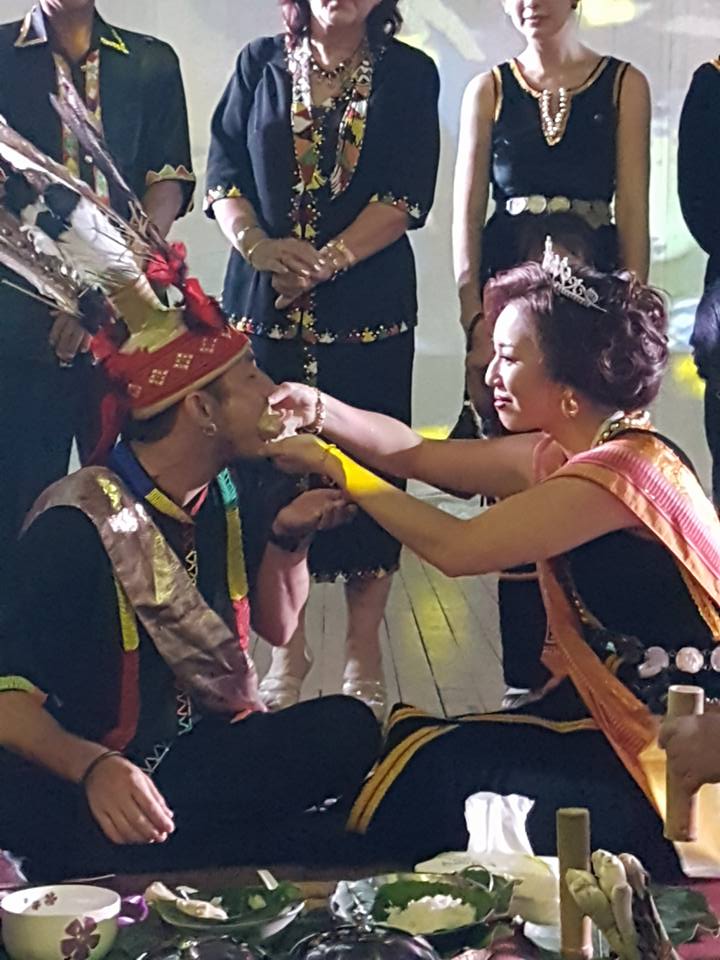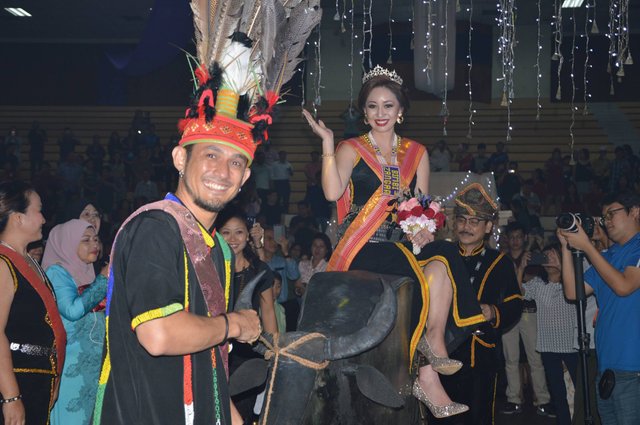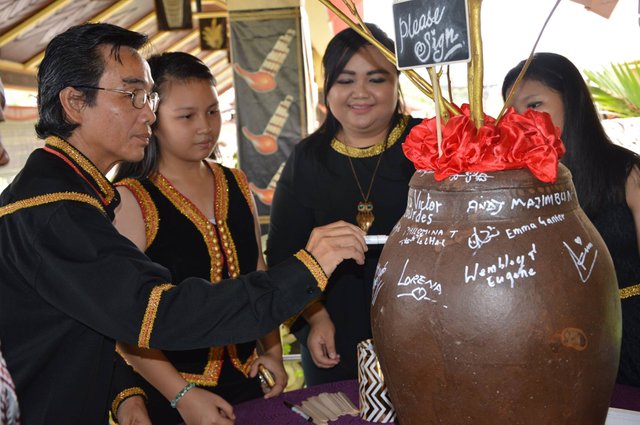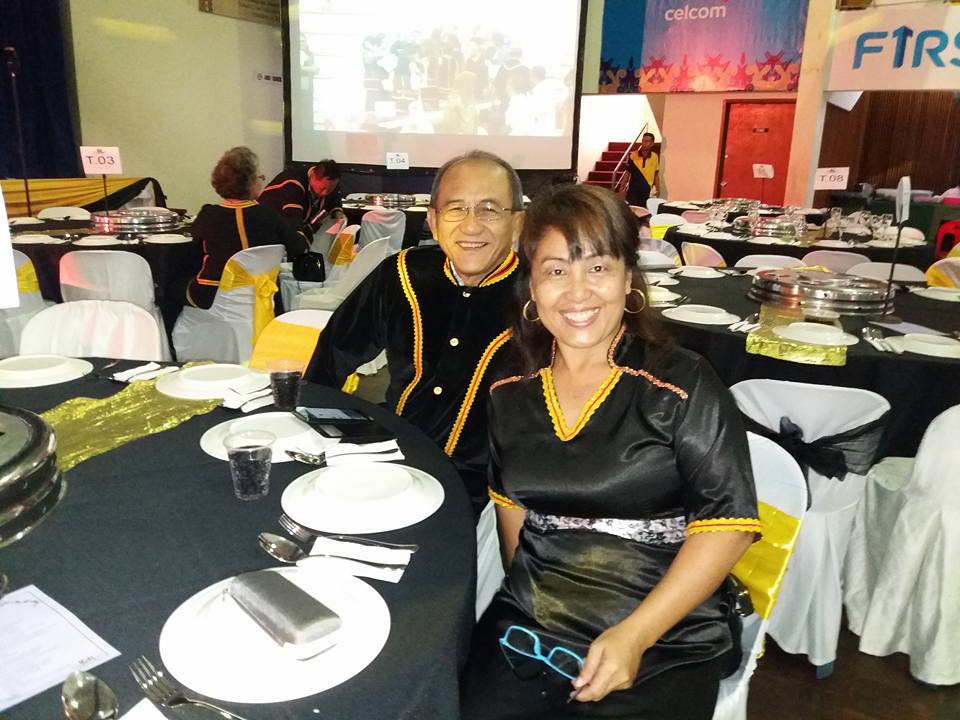The Kadazan Wedding- Only in Sabah
Most weddings today are conducted in very modern fashion with all the IT, video and fanciful adornments being used. Despite these modern trappings, there is still nostalgia for the old customs and tradition which, brings a lot of sentimental values to many Kadazan families. Many had opined that if it is not followed will soon disappear into the dim past.
However, all is not lost. The recent wedding held at KDCA, Penampang saw a significant Kadazan wedding ceremony where the old customs and tradition were displayed in its full array.
‘Miohon Pinisi’ was highlighted as one of the solemn ceremony at the wedding of Chloe Bimbizangan Majinbon and Rian Sanseh Masi. It is a symbolic gesture as the beginning of new life of the newly wedded couple. The bride and groom would be seated together and fed each other with simple meal of rice, meat (chicken) and soup. Some words were recited while the ceremony was on going.
It was Molly Luping, an 80 year old grandmother of Chloe-the bride who encouraged and insisted that traditional ritual such as ‘Miohon Pinisi’ be included in the wedding. She said this ‘ritual’ had longed been practised even during her teenaged year decades ago.
Despite her advanced age, Molly could still relate clearly what the rituals or ceremonies that had taken place when she was just growing up. Today, she wants to impart the knowledge she has to the present generation.
Chloe who has Kadazan-Chinese blood married her sweetheart, Rian Sanseh Masi of Murut and German parentage. It was a blend of cultures set and presented beautifully on their special day that made the wedding uniquely interesting to see and to ponder how two people could unite in marriage albeit a difference in culture.
Chloe’s mother, Esther Sikayun said her daughter’s second name ‘Bimbizagan means butterfly.
Molly emphasised that the cultural importance of preserving one’s culture is part of life’s responsibility and that if not undertaken now, then it will never be a legacy for the future generation to savour.
“Today, it is my granddaughter’s special day and I insist that the tradition be carried out well and précised. This sends a clear message to our guests that we as Kadazans, are rich in culture and we ought to be proud of what we have and who we are,” Molly said adamantly.
On the 1st July 2017 Chloe and Rian officially became husband and wife. One week later, they held their traditional ceremonial wedding at KDCA attended by special guests, friends and relatives.
The usual scene at any wedding receptions, guests would normally sign their names on the guest attendance book provided. However, at Chloe’s wedding, a jar was placed on a middle of the table (instead of book) to allow guests to write their names on it.
This unique way of signing guests’ attendance was the idea of Esther, Chloe’s mother.
“A jar was given to me by my mother. It was originally owned by my grandmother and I really treasure it very much. I was thinking very hard how I could make use of the jar at Chloe’s wedding. Then, the idea of using it as ‘guest book’ just popped out.
I thought it is more useful that way instead of using the usual guest book as it will be kept inside the drawer for a hundred years and we’ll forget about it. While, the jar can be displayed on the living room and will constantly remind everyone about the wedding and their invitees,” Esther explained with grin.
While inside the hall, guests who had arrived earlier were serenaded with songs of yesteryears. The ambience was relaxing and somehow good and active vibes were felt. It was as though everyone inside the hall were reminiscing the good old times they once had in their life.
One of the oldies songs played entitled, ‘Bimbizangan’, which happened to the bride’s second name, was somewhat making the ambience emotional yet having good fun recalling some good memories.
While the merry making was on going, the emcee made announcement that the newlyweds would soon make their grand entry.
It was a pleasant surprise indeed when a replica of a buffalo carrying Chloe caught the attention of the guests, and was being pulled by the hero, none other than the groom himself!
The entrance was unique and again, it amazed all the guests who were standing in awe and waiting for more surprises before their eyes.
Blasius Binjua, the narrator of the Miohon Pinisi’ event shared that, buffalo was a sacred animal as it gave life to people, sacrificed itself in many ways such as being a ‘vehicle’ in those days.
“The presence of the replica of buffalo carrying the bride is another beautiful symbolic gesture that this animal was part of our ancestors’ life in the early days. It was and still is a symbol of strength and unity. By parading it at this wedding would add the excitement and at the same time reminds all of us of our forefather’s life then,” claimed Blasius.
Some of the guests were heard asking, ‘What’s next?’ after they witnessed the ‘buffalo’ bringing the bride into the hall.
It was a total enjoyment with exciting moment, and aside from experiencing the traditional ‘taste’ of the life of the Kadazan people, it was also an educational event on the other hand.
Blasius added that although not many Kadazans are farming these days, he opined that people should remember the survival of their ancestors’ was due to buffalo which acted as carrier and transporter in the early days.
Just before the couple began the ‘Miohon Pinisi session which was conducted on the stage, the couple were asked to step on a stone placed at the bottom of the stairs while granny Molly recited some verses which was then translated by Blasius in English.
The verses said were as follows,
Stepping on a stone session
Molly: Rian om Chloe, Nah! Siungan ku iziozu diti suing, do pongumohig do onu nopo ih tangalaat do dumonto.
(Rian and Chloe, please put on this hat as a symbol of the guardian in your life. It shall be your shield for life to protect both of you from harm and all evil)
Molly: Rian on Chloe, Saakoi kou no diti hamin diozu, om impau kou no diho vatu do pampang, ih tokodou ii au miho do ababak. Om ingkaa nogi oh pogigizon diozu do sogigisom, okodou om opinto tomoimo, miaga diti vatu pampang tu au miho ababak.
(Rian and Chloe, as you enter your house, step on the stone, not an ordinary stone but a solid rock. Strong and firm it is and does not fall apart nor disintegrate, and so shall your family of love remains strong, firm and unimpaired till the end of time)
Molly: Iti no ngavi o pomokis ku diozu
(As my blessing, I shall sprinkle you with this bundle of assorted fresh leaves – symbol of love of our ancestors and I pass down to both of you)
Miohon Pinisi session (first meal of the newly weds)
Molly: Nah, akano no diozu ino naig, naig do kotimpuunan diozu do iso paganakan tavasi.
(Take this ball of rice, as it is sacred among our Kadazan race. It signifies life. This is an important landmark of the beginning of a good family)
Molly: Om iupo’ no diozu ino napa do soko miampai do tonsi manuk
(Take this soup of bamboo shoots and chicken)
Molly: Poing nopo nga tikid vuhan do momusoko, om ingkaa kou nogi.
(Bamboo shoots sprout in abundance and so shall you multiply in the same manner)
Molly: Inumo no siozu ino nasi, ih vonod mantad naig sinasadan om navangun mantad paai tosundu. Abagos nopo do moobuvat om tomoimo do kipaai. Kipaai nopo om tomoimo do kaakan, koinum om kiva pizunguan om piobohutan.
(Drink the rice wine, the essence of the fermented rice which comes from the sacred paddy. When we sweat and toil our land there is paddy. When we have paddy, we’ll have enough to eat, drink and good fellowship and friendship)
Blasius then explained that this was how weddings were celebrated as taught by the forefathers since time immemorial. It was at one time forgotten through the passage of time but now miraculously revived because of the undying spirits of our people for the sake of the young generation.
Esther recalled her own wedding some thirty years ago to William Majinbon where it became a turning point for her family to keep the tradition alive. Chinese tradition was very much practised then as her husband, William was a Buddhist at that time and his family were strongly practising their Chinese culture such as tea ceremony and other rites.
“Mum realised that we had nothing to show on our side, whereas on my husband’s side, they were well prepared with the Chinese custom during our wedding.
I was naïve and just followed what my in laws had prepared for us, such as the tea ceremony which I thought was something nice and beautiful to be part of it as it created great bonding and exciting too,” she smiled.
Molly recalled at Esther’s wedding in 1987 there wasn’t any preparation of Kadazan rituals as none of them thought any of it. However, Molly’s brother, Herman (Tan Sri Herman Luping) confronted her ‘Nunu di do tokou?” Nokuo tu aiso ponong dotokou? (what happen to our (Kadazan) ritual? Why are we not carrying out ours?” Molly recalled how her brother questioned her.
“It was really a turning point for me and Herman to immediately think of including the Miohon Pinisi at the wedding. With little time to prepare, we managed to have a simple Miohon Pinisi session.
Esther related that customs and traditional ceremonies handed down by the ancestors are priceless and it is akin to an heirloom to the family.
Mary Coleman, Esther’s older sibling flew all the way from New Zealand with her husband to witness Chloe’s wedding.
“This is definitely the wedding of the centuries,” said Mary who was impressed with the whole arrangement where efforts to revive the original Kadazan wedding a success. She hoped that other couple would practise their respective culture, so that there is continuity in preserving such priceless heritage.
Although most of the past events are not recorded or written in hardcopy, Molly said almost every step of the rituals is very much ‘alive’ in her thought. She however urged her children to help revived by recording every information that she has into a physical book for the benefits of the next generation.
Molly’s eldest son, Datuk John Sikayun agreed with his mother, saying traditional event like Miohon Pinisi is nothing new and that many kadazan weddings had included this as part of the programme, however it should be elaborated and explained in more details so that audience would understand the meaning behind such event.
“Mum has all the information first-hand because she experienced it, she participated in it, she talks fondly about it and she is passionately sharing it to anyone who wants to know further.
Therefore, I can say that whatever knowledge or evidence she has, is deem reliable and authentic,” John shared.
Chloe said it is heartening to note that she did not intend to see the customs that were displayed and carried out at her own wedding to end. She intends to document all details (events) via photos and video clips taken to be perpetual, a reminder of the rich marriage customs in Kadazan culture.
“I had heard about it, I had witnessed it and now I am part of the beautiful and meaningful ceremony,” said Chloe who is determined to keep this tradition alive in her family so that she can hand down whatever knowledge and memory about it to her children in the future.
“What is the point of being a Kadazan, but we are not appreciating our own culture. Such priceless and beautiful culture of our own should be upheld as long as we are still living. After all, this is the only invaluable legacy we have,” said Chloe.




